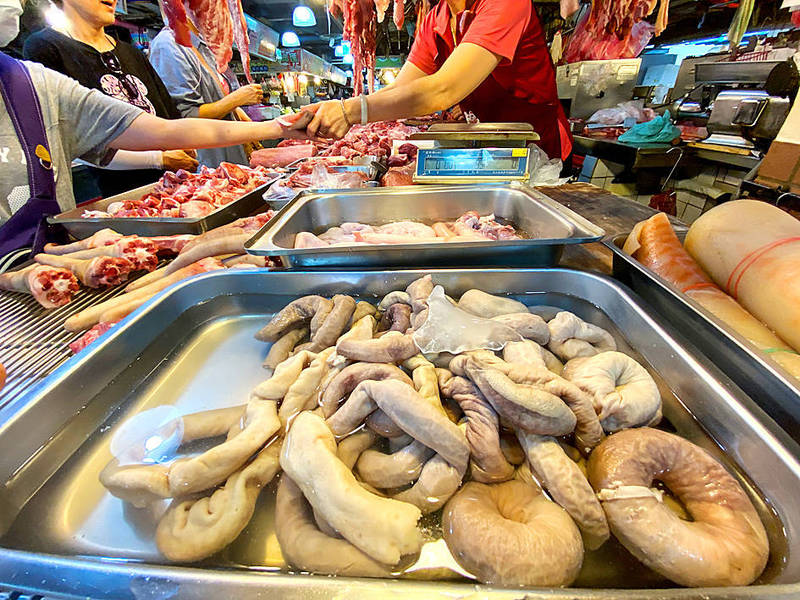《TAIPEI TIMES》Ministry announces ractopamine limits

Minister of Health and Welfare Chen Shih-chung holds up a sign at a news conference in Taipei yesterday with two labels displaying different countries of origin for pork sold in stores. Photo: Chang Chia-ming, Taipei Times
NEW MEASURES: From Jan. 1, all pork products sold anywhere, including at food stalls, traditional markets and restaurants, must be legibly marked with the country of origin
By Lee I-chia
Staff reporter
The Ministry of Health and Welfare yesterday announced the maximum residue limits (MRLs) for US pork containing ractopamine: 0.04 parts per million (ppm) for liver and kidneys, and 0.01ppm for all other parts of the animal.
Minister of Health and Welfare Chen Shih-chung (陳時中) said that to protect people’s health, the MRLs for US pork containing ractopamine were based on scientific evidence and health risk assessments.
President Tsai Ing-wen (蔡英文) on Aug. 28 announced that the government would lift bans on US pork containing ractopamine and US beef from cattle more than 30 months old. The policy is scheduled to take effect on Jan. 1 next year.
A food hygienic safety and nutrition consultative council was convened by the ministry on Friday to discuss the appropriate MRLs for Taiwan.
“The MRL for ractopamine residue in pork will be set at 0.04ppm for pork liver and kidneys, and 0.01ppm for pork fat and all other edible parts,” Chen said.
In other countries, most of the MRLs for ractopamine in kidneys are set at 0.09ppm or higher, but the MRL for kidneys in Taiwan would be 0.04ppm, because the council took into consideration that it is customary in Taiwan for new mothers to eat liver and kidneys, he said.
The MRL for pork liver would also be set at 0.04ppm, he said, adding that the Codex Alimentarius Commission advises an MRL of 0.04ppm, which Japan, South Korea, New Zealand and Canada adhere to, while the US and Australia use MRLs of 0.15ppm and 0.2ppm, respectively.
While US beef from cattle more than 30 months old would be allowed to be imported, beef parts with a higher risk of containing bovine spongiform encephalopathy (BSE), commonly known as mad cow disease, would still be banned, Chen said.
Beef parts with a high BSE risk include the skull, brains, eyes, spinal cord, ground meat and internal organs, the ministry said.
The ministry referred to 2018 data evaluating the health risk of eating beef from cattle of all ages, and on Tuesday consulted BSE specialists, who agreed that lifting the ban on beef from cattle aged 30 months or older would be safe, Chen said.
Meanwhile, starting from Jan. 1, all pork products, including braised pork rice or meatball soup, sold anywhere — including traditional markets and food stalls — must be legibly marked with the country of origin, Chen said.
The country of origin must be labeled on prepackaged foods, signs marking the countries of origin must be put out for bulk pork products, and food stalls and restaurants would be required to put up clearly visible signs that state the country of origin of their pork dishes, Chen said.
He said that after the ministry officially announces the standards, it would set up demonstration areas nationwide to promote correct labeling methods and collect suggestions from stores.
The Food and Drug Administration (FDA) would also implement a tracing system to verify the accuracy of labels, he added.
Chen said that companies that fail to legibly mark the country of origin of their pork products would face a fine of NT$30,000 to NT$3 million (US$1,016 to US$101,568), while those who falsify their labeling would face a fine of NT$40,000 to NT$4 million, according to the Act Governing Food Safety and Sanitation (食品安全衛生管理法).
FDA Director-General Wu Shou-mei (吳秀梅) said that a fine of NT$60,000 to NT$200 million could be given to suppliers of pork products that do not meet the MRL standards for ractopamine.
新聞來源:TAIPEI TIMES





















